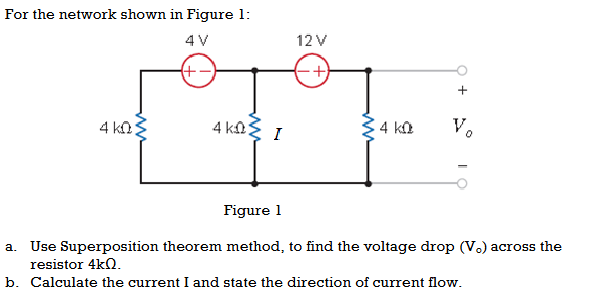For the network shown in Figure 1: a. Use Superposition theorem method, to find the voltage drop (Vo) across the resistor 4kΩ. b. Calculate the current I and state the direction of... For the network shown in Figure 1: a. Use Superposition theorem method, to find the voltage drop (Vo) across the resistor 4kΩ. b. Calculate the current I and state the direction of current flow.

Understand the Problem
The question is asking to apply the Superposition theorem to determine the voltage drop across a 4kΩ resistor in the given circuit. Additionally, it requires calculating the current I and identifying its direction.
Answer
The voltage drop across the 4kΩ resistor is \( V_o = 8V \) and the current is \( I = 2mA \), flowing from the positive terminal of the 12V source.
Answer for screen readers
The voltage drop across the 4kΩ resistor, ( V_o ), is ( 8V ) and the current ( I ) is ( 2mA ), flowing from the positive terminal of the 12V source.
Steps to Solve
-
Identify Individual Sources To apply the Superposition theorem, we need to analyze the circuit for each independent voltage source one at a time, while turning off the other sources. For voltage sources, we replace them with short circuits.
-
Analyze Circuit with 4V Source When considering the 4V source only:
-
The circuit now has a 4V source and the two 4kΩ resistors in series.
-
Find the current $I_1$ using Ohm's law. The equivalent resistance $R_{eq1}$ is $4kΩ + 4kΩ = 8kΩ$.
-
The total voltage across this resistance is 4V. Thus,
$$ I_1 = \frac{V}{R_{eq1}} = \frac{4V}{8kΩ} = 0.5 mA $$
- Find Voltage Drop across the 4kΩ Resistor The voltage drop across the 4kΩ resistor due to the 4V source is:
$$ V_{4kΩ,1} = I_1 \cdot 4kΩ = 0.5mA \cdot 4kΩ = 2V $$
- Analyze Circuit with 12V Source Now, only consider the 12V source:
- We have the 12V source and both 4kΩ resistors in parallel.
- The equivalent resistance $R_{eq2}$ is:
$$ R_{eq2} = \frac{(4kΩ \parallel 4kΩ)} + 4kΩ = 2kΩ + 4kΩ = 6kΩ $$
- The current $I_2$ through the circuit can be calculated as:
$$ I_2 = \frac{12V}{6kΩ} = 2mA $$
- Find Voltage Drop across the 4kΩ Resistor The voltage drop across the 4kΩ resistor due to the 12V source is:
$$ V_{4kΩ,2} = \frac{(4kΩ \cdot 12V)}{(4kΩ + 4kΩ)} = \frac{4kΩ \cdot 12V}{8kΩ} = 6V $$
- Add Voltage Drops for Total Voltage Now sum the voltage drops from both sources to find the total voltage drop $V_o$ across the 4kΩ resistor:
$$ V_o = V_{4kΩ,1} + V_{4kΩ,2} = 2V + 6V = 8V $$
- Calculate Total Current and Direction The total current $I$ across the circuit is the same as the current $I_2$:
$$ I = I_2 = 2mA $$
Since the 12V source drives the current through the circuit, the direction of the current $I$ flows from the positive terminal of the 12V source towards the resistor.
The voltage drop across the 4kΩ resistor, ( V_o ), is ( 8V ) and the current ( I ) is ( 2mA ), flowing from the positive terminal of the 12V source.
More Information
The Superposition theorem is a powerful technique in circuit analysis that allows for simpler calculations by considering one source at a time. This method helps in understanding how each source contributes to the overall circuit behavior.
Tips
null
AI-generated content may contain errors. Please verify critical information